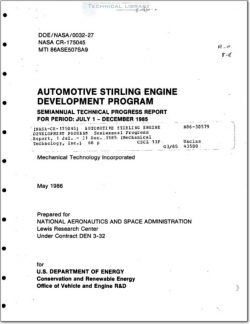NASA-CR-175045

- Version
- 55 Downloads
- 5.24 MB File Size
- 1 File Count
- August 14, 2016 Create Date
- August 14, 2016 Last Updated
Automotive Stirling Engine Development Program

INTRODUCNON
In March 1978, a Stirling-engine develop-
ment contract, sponsored by the Depart-
ment of Energy (DOE) and administered by
National Aeronautics and Space Adminis-
tration (NASA)/Lewis Research Center,
was awarded to Mechanical Technology In-
corporated_(MTI) for the purpose of de-
veloping an Automotive Stirling Engine
(ASE) and transferring Stirling-engine
technology to the United States. The
program team consisted of MTI as prime
contractor, contributing their program
management, development, and technolo-
gy-transfer expertise; United Stirling
of Sweden (USAB) as major subcontractor
for Stirling-engine development; and AM
General (AMC) as major subcontractor for
engine and vehicle integration.
Most Stirling-engine technology previ-
ously resided outside of the United
States, and was directed at stationary
and marine applications. The ASE Devel-
opment Program was directed at the estab-
lishment and demonstration of a base of
Stirling-engine technology for the auto-
motive application by September 1984.
The high-efficiency, multi-fuel capabil-
ity, low-emissions, and low-noise poten-
tial of the Stirling engine made it a
prime candidate for an alternative auto-
motive-propulsion system.
ASE Program logic called for the design
of a Reference Engine System Design
(RESD) to serve as a focal point for all
component, subsystem, and system devel—
opment within the program. The RESD was
defined as the best-engine design gener-
ated within _the program at any given
time. The RESD would incorporate all new
technologies with reasonable expecta-
tions of development by the end of the
program and which 'provide significant
performance improvements relative to the
risk and cost of their development. The
RESD would also provide the highest
fuel economy possible while still meeting
other program objectives.
A schedule was defined within the ASE
Program to design two experimental engine
versions of the RESD. The first-genera-
tion engine system, the Mod I, was de-~
signed early in the program, and has been
on test since January 1981. The second-
generation engine, designated the Mod II,
was originally scheduled to be designed
in 1981 to demonstrate the final program
objectives. However, it was postponed to
1984 due to Government funding cutbacks.
Through the course of the program, the
Mod I has been modified and upgraded
wherever possible, to develop and demon-
strate technologies incorporated in the
RESD. Asia result, the program followed
a "proof-of-concept" development path
whereby the Upgraded Mod I design emerged
as an improved engine system, proving
specific design concepts and technolo-
gies in the Mod II that were not included
in the original Mod I design. This logic
was recognized as having inherent limita-
tions when it came to actual engine hard-
ware, since Mod I hardware was larger
and, in some cases, of a fundamentally
-different design than that of the Mod II.
Nevertheless, some of the new technology
incorporated in the RESD has been suc-
cessfully transferred to the Upgraded Mod
I_engine. Iron-based materials were used
in place of costly cobalt-based materials
in the Hot Engine System (HES) which was
‘ designed to operate at 820°C heater head
temperature (the Mod I was tested at
720°C). Smaller, lighter designs were
incorporated into the upgraded engine to
optimize for better fuel economy and to
reduce weight (the Upraded Mod I engine
was 100 lb lighter than the Mod I). The
RESD has been revised periodically
throughout the course of the program to
incorporate new concepts and technolo-
gies aimed at improving engine efficiency
| File | Action |
|---|---|
| NASA-CR-175045 Automotive Stirling Engine Development Program.pdf | Download |
Comment On This Post